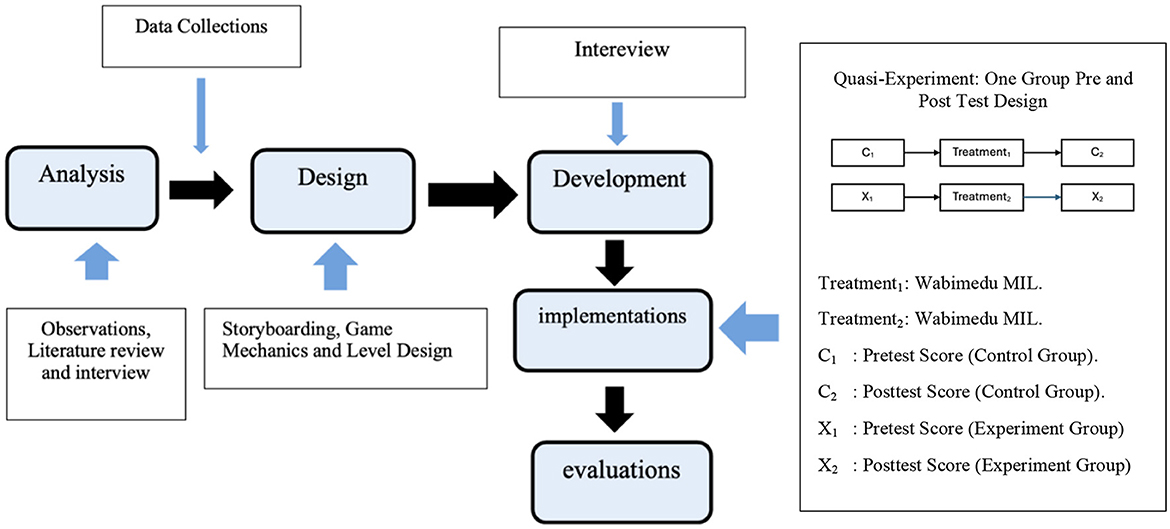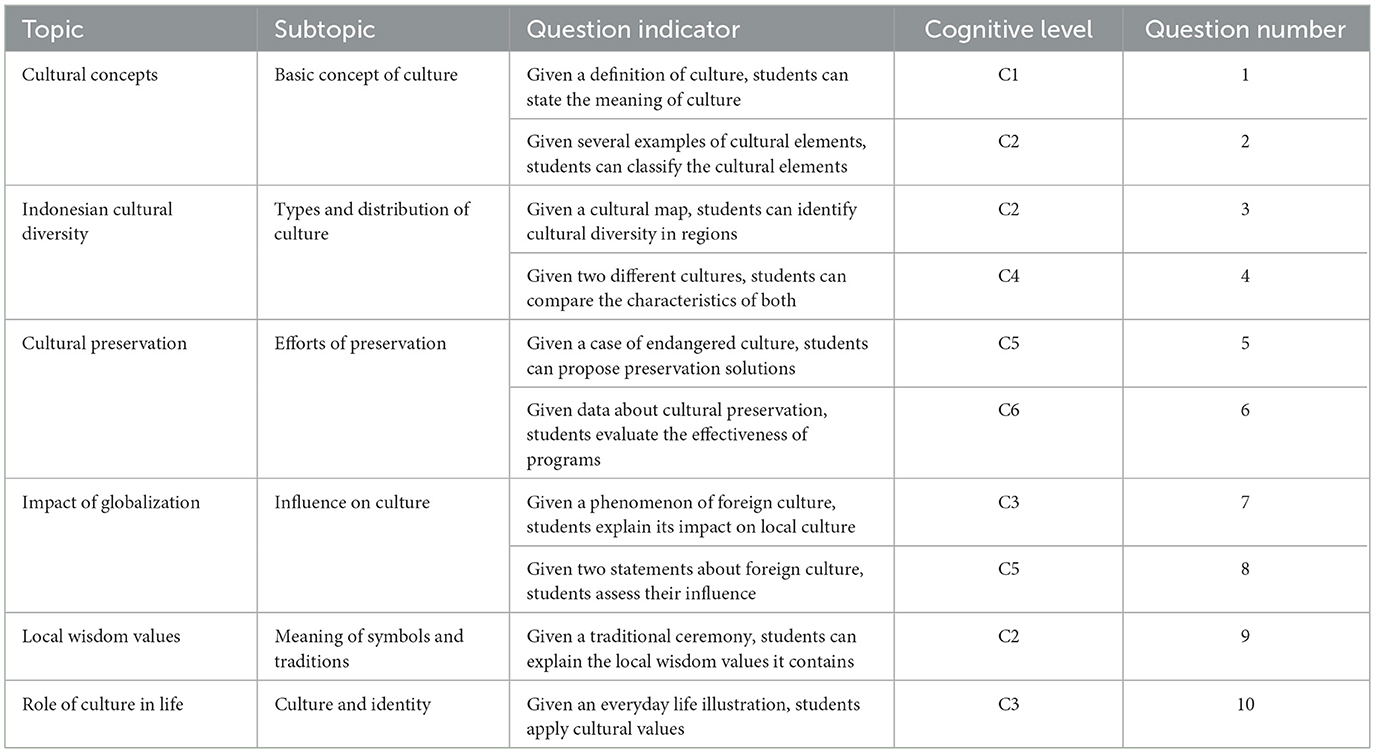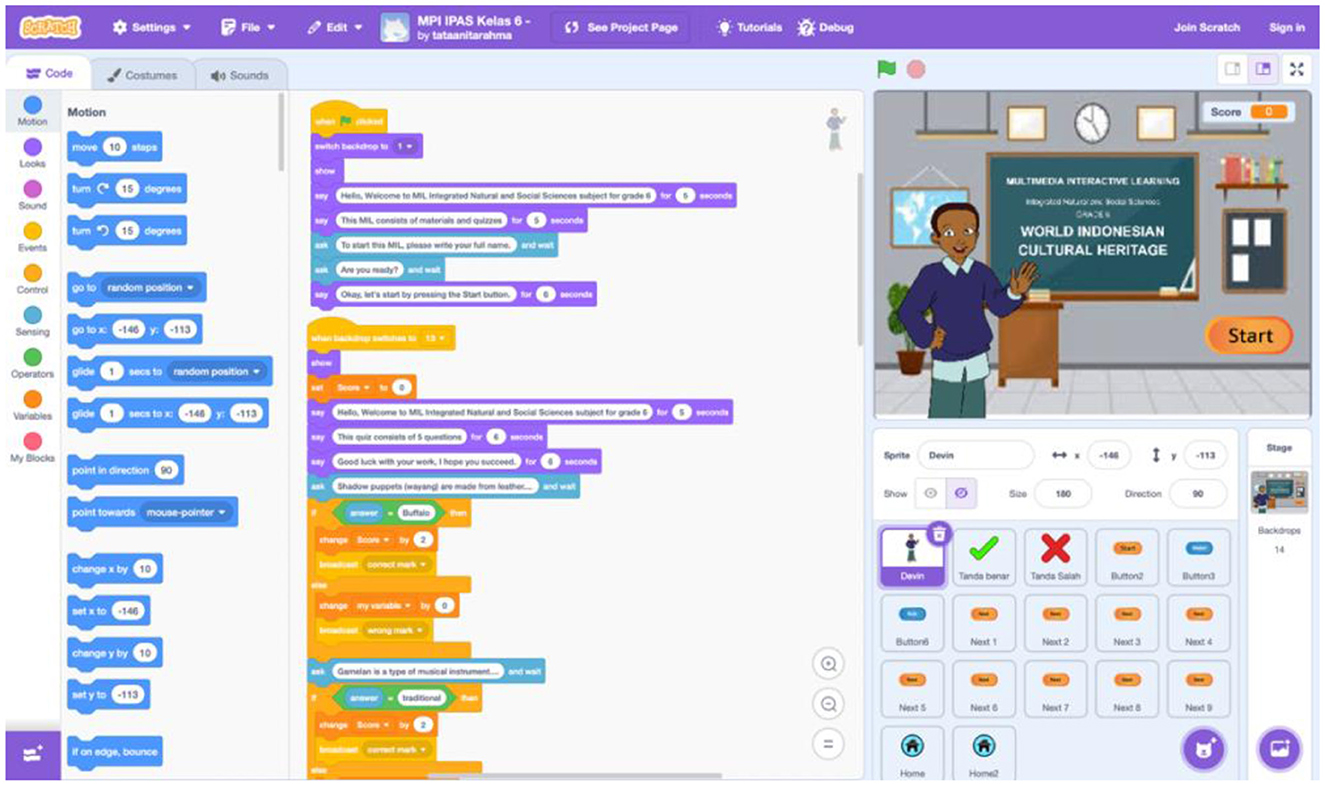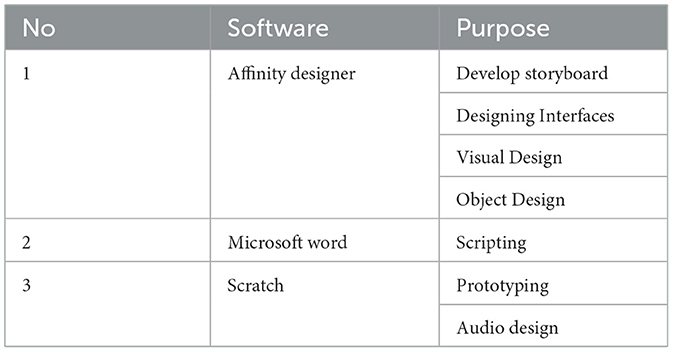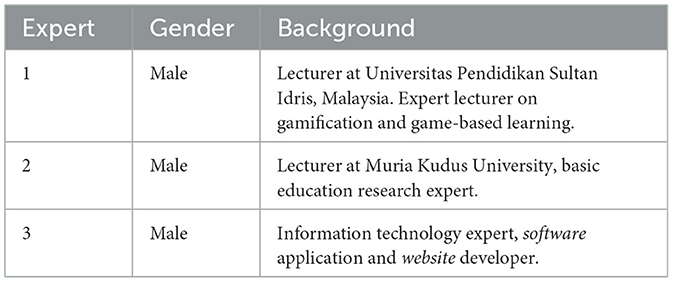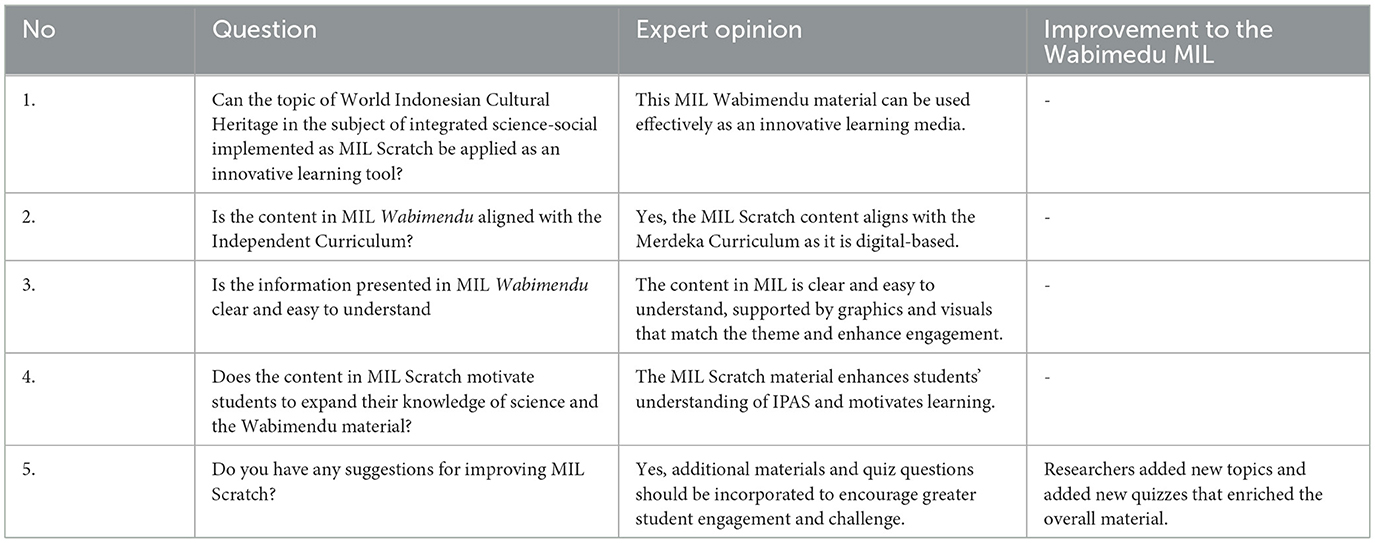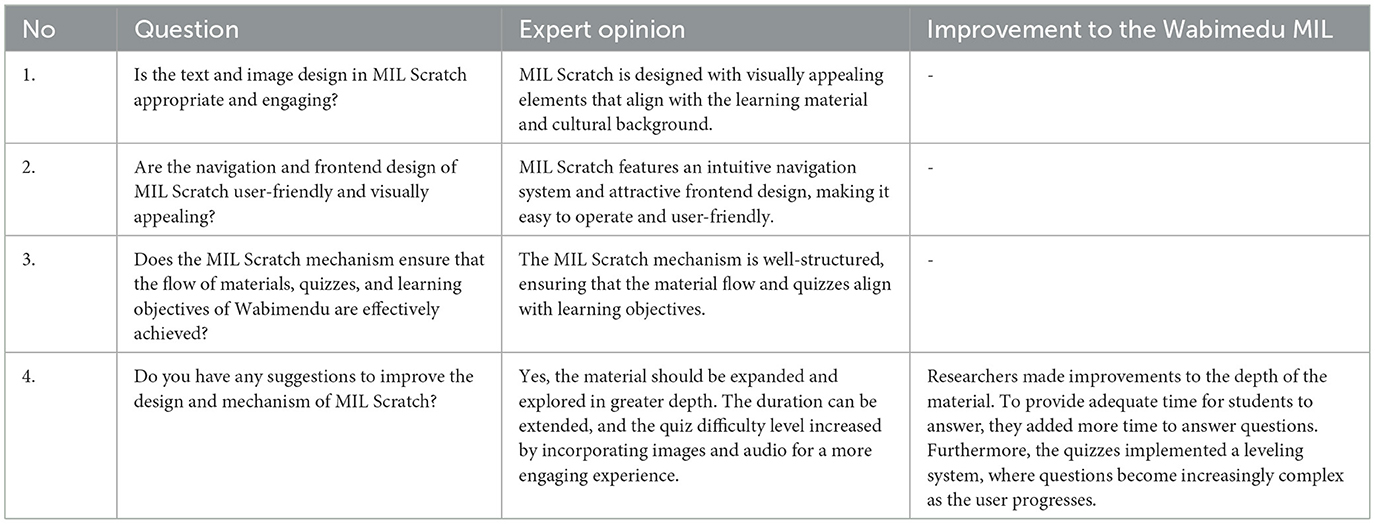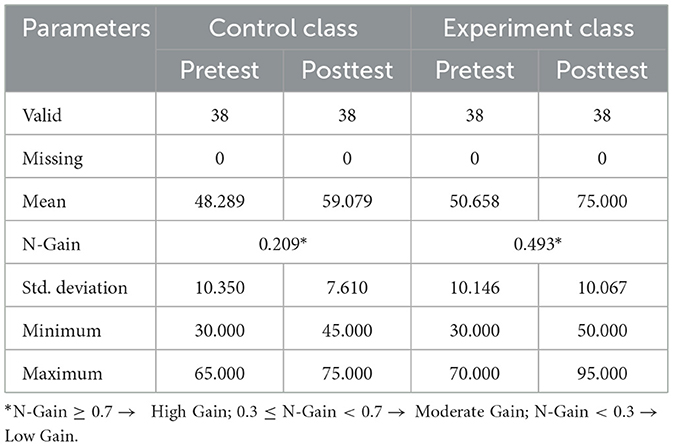- 1Primary Teacher Education Study Program, Universitas Muria Kudus, Kudus Regency, Central Java, Indonesia
- 2Master of Primary Education, Universitas Muria Kudus, Kudus Regency, Central Java, Indonesia
- 3Faculty of Technical and Vocational, Sultan Idris Education University, Tanjung Malim, Perak, Malaysia
- 4Faculty of Science and Mathematics, Sultan Idris Education University, Tanjung Malim, Perak, Malaysia
Introduction: Using digital technologies helps enhance learners' interest and participation in classes such as Integrated Natural and Social Sciences (IPAS). The purpose of this study is to create animated interactive learning multimedia using Scratch that aims to teach Indonesian cultural heritages that have received international acknowledgment in a stylized and engaging way.
Methods: The research and development (R&D) of the interactive learning multimedia, Scratch Wabimendu, was conducted using the ADDIE model, which consists of analysis, design, development, implementation, and evaluation. The effectiveness of the intervention was evaluated through a quasi-experimental study employing a non-equivalent control group design. Data were collected through in-depth interviews with three experts in game-based learning, education, and software development.
Results: Experts reported that the implementation of Scratch Wabimendu MIL (Multimedia Interactive Learning) resulted in increased engagement, motivation, and comprehension among learners. The findings also revealed that the media was successfully developed, and students who were exposed to it exhibited significant improvements in learning outcomes. Inferential analyses demonstrated these improvements, with normalized gains of 0.493 for the experimental group and 0.209 for the control group (p < 0.001), accompanied by a substantial effect size (Cohen's d > 1.726).
Discussion: Thus, Scratch Wabimendu has been well developed and serves as an effective instructional media for enhancing the learning outcomes of learners while fostering a greater understanding of Indonesia's cultural history and heritage.
1 Introduction
The rapid advancement of technology has created an educational gap in finding new channels for conveying learning media. One of the primary challenges in elementary schools is enhancing learner motivation, particularly in the subject area of integrated natural and social sciences (IPAS). In accordance with Fatimah et al. (2024), IPAS is important because it helps build students' interest in natural and social events around them. Interest is one of the factors that motivates students to study the world and the interactions between human life and the Earth.
As a result of static reading materials and conventional teaching approaches lacking dynamism (Malliga et al., 2024), such approaches lead to Mustofa et al. (2024) and Sutini and Rasyid (2021), which significantly reduce student comprehension and engagement (Mengesha et al., 2024). Miura (2022) contributes to the literature by highlighting Indonesia's internationally recognized cultural heritage, as exemplified by batik, traditional dances, and wayang kulit. However, the extent to which students appreciate their cultural heritage is still minimal (Ratri et al., 2025). Developing an appreciation of national identity and pride among the young generation is critical (Parmin et al., 2024); it can be facilitated by integrating innovation in technology and cultural values to make education more appealing and relevant (Mustofa et al., 2021; Purbasari et al., 2023).
A technology-oriented platform, such as Scratch, may offer a viable solution for the challenge at hand. According to Azman et al. (2025) and Mohd Asri and Jamaludin (2022), Scratch is a product of the MIT Media Lab, offering both online and offline access. As such, users can create multimedia, interactive learning materials. Learning becomes easier and students can grasp complex concepts through engaging and intuitive learning experiences, which make the content more accessible (Batni et al., 2025; Sáez-López et al., 2020). With Scratch, educational content, such as batik and traditional games, can be animated and rendered interactively (Azman et al., 2025).
Although the benefits of Scratch education have been well-documented in subjects such as science and mathematics, a critical research gap remains in its application to cultural heritage education. This is not merely an oversight but rather a significant missed opportunity. Conventional teaching methods often fail to make cultural history engaging for digital-native learners, contributing to a well-documented decline in students' appreciation for their heritage (Miguel-Revilla et al., 2020; Mokhsin et al., 2019). Traditional pedagogical methods typically align with behaviorist learning theories, which view students as passive recipients of information, with educators acting as the primary source of knowledge (Agarkar, 2019; Ansar et al., 2021). This form of learning focuses on students completing tasks, answering tests, and operating at a surface level that does not foster curiosity or deeper inquiry (Lu et al., 2021; Lynn, 2020). In contrast, learning through Scratch technology embodies a constructivist approach, where students build understanding and knowledge through their experiences and interactions with various stimuli in the environment (Ansar et al., 2021). This approach offers students creative and analytical activities that make learning more engaging (Machumu and Zhu, 2017; Nyathi and Sisimayi, 2024; Stylianou and Savva, 2022). This theoretical gap highlights how Scratch can be better integrated into modern educational paradigms that adopt a constructivist framework, combining multimedia techniques with purposeful design elements that stimulate intrinsic engagement.
The failure to utilize engaging technologies like Scratch in this domain perpetuates a pedagogical gap, leaving a vital tool untapped in the effort to foster national identity and pride in a modern context. Moreover, there is a lack of research investigating how culturally-focused Scratch applications influence digital literacy and align with project-based learning (PjBL) methodologies within the framework of Indonesia's national curriculum. This study directly addresses this gap. To tackle this issue, our research introduces the development and evaluation of “Wabimendu” (short for Warisan Budaya Dunia Indonesia or Indonesian World Cultural Heritage), an Interactive Multimedia Learning (MIL) tool created using Scratch. The novelty of this research lies in the strategic integration of authentic local cultural elements—such as batik and wayang kulit—with an interactive and gamified learning environment. Wabimendu is designed not only to teach facts about Indonesian culture but also to actively enhance digital competence and foster a deeper, more intrinsic appreciation of this heritage among elementary school students.
Therefore, this study aims to create and validate a Scratch-based learning tool that enhances IPAS (science, environment, and social studies) learning experiences by making them more immersive, enjoyable, and culturally resonant. Ultimately, this research seeks to contribute a relevant and modern educational resource for the digital era that effectively integrates technology with cultural preservation and the national education curriculum.
2 Literature review
2.1 Interactive multimedia-based development scratch
Scratch is a programming language that is free to use and allows novices to create programs without the burden of correct syntax (Dúo-Terrón, 2023; Maloney et al., 2010). Operating as a visual programming language, Scratch facilitates the creation of interactive learning media, aligning with the Cognitive Theory of Multimedia Learning (Mayer, 2014, 2024), which posits that multimedia is most effective when information is presented in an interactive format that combines text, pictures, animations, and audio. Prior studies have shown Scratch's effectiveness in improving students' learning motivation in the areas of science and mathematics (Kalemkuş and Kalemkuş, 2025; Mo et al., 2021). Its use in non-science subjects, such as cultural heritage education, is still underutilized.
2.2 Culture-based learning
Culture-based learning incorporates local and distinct aspects of culture into teaching, thereby enhancing learners' awareness of their own culture as well as that of others (Young, 2014). This method has several advantages and applications in the field of education. The inclusion of local culture in the learning process not only increases student interest (Zhang et al., 2025) but also fosters a deeper appreciation of the culture's heritage while learning new languages or subjects.
Particular to cultural learning, mimetic learning takes center stage where learners acquire knowledge through imitation and engagement in cultural activities (Trinh and Dinh, 2024). This form of learning facilitates the acquisition of knowledge, as well as socialization and the internalization of social behaviors and norms. Additionally, mimetic learning fosters a sense of community and socialization, which is crucial for a person's overall development. Within organizations, cultural learning combines practice-based teaching with cognitive anthropology (Hasse, 2015), enabling individuals to competently handle cultural differences —a necessity in today's global market. It emphasizes the fluidity of culture and the need for intercultural learning.
To incorporate culture into learning frameworks, practitioners must consider students' cultural backgrounds when developing lesson plans. This also means employing suitable materials and engaging activities that are appropriate to students' contexts. Reflective practices, such as Digital Exchange Programs (Dawes Duraisingh et al., 2021), allow students to Learn about culture(s) via intercultural digital exchange and linguistic citizenship. Additionally, Algerian EFL Teachers' didactic approaches (Hadjeris, 2025) emphasize embracing pluralism through a “pluriversal” approach.
Moreover, the application of technology is critical to the enhancement of cultural learning (Ma et al., 2024). Educational technology can transform passive cultural materials into dynamic and participatory learning activities, thereby enhancing students' engagement with cultural heritage. For example, Computer-Assisted Language Learning (CALL) can incorporate cultural components, enabling learners to appreciate their own culture and that of others as they learn a new language (Trinh and Dinh, 2024).
2.3 Interactive learning theory
The development of interactive Scratch-based media is informed by learning theories such as constructivism (Brau, 2020) and the Zone of Proximal Development (ZPD) (Anish et al., 2021; Poehner and Lantolf, 2021). Constructivism emphasizes the notion that students construct knowledge through interaction with learning media. In contrast, ZPD expands on the necessity of scaffolding, where the support provided enables students to master increasingly complex ideas (Zhang et al., 2018).
In designing any interactive learning experience, the combined application of constructivist learning theory and interactive media must be holistically integrated and work in synergy. Xu and Zhao (2024) stated that interactive media is a derivative of the growing field of multimedia, offering a unique interface for bidirectional communication that differs from face-to-face interaction in many ways. Interactive media encourages active participation, as learners can make choices and thereby gain a greater understanding while learning at their own pace.
3 Method
3.1 Research design
As described in the work of (Bada et al., 2024), this study employs ADDIE as a case study in the research and development (R&D) paradigm, a methodological approach that systematically and rigorously concerns instructional design. This model outlines five main steps in the construction of educational resources, namely: Analysis, Design, Development, Implementation, and Evaluation. In the context of this study, the research and development (R&D) process, utilizing the ADDIE model, is carried out up to the Implementation stage. As represented in Figure 1, the ADDIE model workflow is as follows:
The process began with the Analysis phase, which involved a needs analysis to identify the core educational challenges: low student motivation in IPAS subjects and a documented lack of appreciation for local cultural heritage. A content analysis was also conducted to select relevant topics on Indonesian world cultural heritage appropriate for the fifth-grade elementary students who were the target population.
Following the analysis, the Design phase focused on creating a conceptual blueprint for the application. This included developing detailed storyboards for the learning narrative, designing an intuitive user interface, outlining game mechanics to foster engagement, and creating a visual prototype of the media that would serve as the foundation for development.
In the subsequent Development phase, the conceptual design was built into a functional, interactive application using the Scratch platform. A crucial component of this stage was formative evaluation, where the initial product was rigorously reviewed by three experts with backgrounds in gamification, basic education research, and software development. Their feedback and suggestions informed significant improvements and refinements to the media before its classroom deployment.
Finally, The Implementation phase consisted of deploying the refined “Wabimendu” media in a real-world classroom setting. The media served as the primary instructional tool and experimental treatment for the experimental group, as part of a quasi-experimental study with a non-equivalent control group, employing a pre- and post-test design. In this phase, we compare the pretest and posttest scores of the experimental and control groups, and determine the impact and effectiveness of the “Wabimendu” media on improving student learning outcomes.
3.2 Population and sample
The population of this study consisted of 95 fifth graders (aged 11–12 years) from three public elementary schools in the Bae District, Kudus Regency, Indonesia. A sample of 76 students was drawn from this population, a number considered to be suitable according to the calculation formulated by Krejcie and Morgan (1970). All participating schools used the national “Merdeka Curriculum,” which guaranteed curricular uniformity for the sample. An initial analysis ascertained that the students shared similar demographic backgrounds and starting academic competencies. Additionally, their prior formal learning about Indonesian world cultural heritage through the IPAS curriculum was minimal, and their digital literacy competencies were at a basic level, making them an ideal audience for this intervention.
A purposive sampling strategy was used to select the schools and classes that participated. This is a form of non-probability sampling that had specific, practical reasons for being chosen, which were essential for the study to take place. The selection criteria required that the schools not only follow the appropriate curriculum but also have access to the necessary computer laboratory facilities required to run the Scratch-based “Wabimendu” application, and that the school administration and teachers were willing to cooperate and participate in the research schedule.
After selecting this study sample, the 76 participating students were divided into two groups of 38, an experimental group and a control group. To ensure this arrangement met the requirements of a quasi-experimental, non-equivalent control group design, two intact classes were assigned to these groups. A group was taught using the “Wabimendu” multimedia interactive learning tool, while the other group was taught using conventional learning.
3.3 Instrument
The effectiveness of the Wabimendu MIL product was measured using a quantitative cognitive test as a research instrument. This test was designed to assess learning outcomes related to Indonesian cultural heritage topics, with questions based on the national “Independence Curriculum”. The instrument consisted of 10 questions structured according to the revised Bloom's taxonomy (Anderson et al., 2001), encompassing all six cognitive levels from Remembering (C1) to Creating (C6), which has been validated by three primary education curricula and an instructional media expert with a CVI value of 1.0. The instrument has also been tested in a limited pilot study with 15 samples, yielding a Cronbach's alpha value of 0.80, which is considered reliable. A complete test specification outlining the specific topics, question indicators, and corresponding cognitive levels for each item is provided in Table 1. The test items were designed to align with the learning objectives. Scoring was based on a 100-point scale, with student performance on the 10 items calculated to yield a total score. This scoring system was used for both the pretest and posttest to ensure consistency in measuring learning outcomes.
3.4 Data collection
This study collected both qualitative and quantitative data to guide the development and evaluate the effectiveness of the “Wabimendu” learning media. The qualitative data were collected during the development phase using semi-structured interviews, with three experts invited to participate based on their extensive experience (over 10 years) in game-based learning, primary education, and software development. The purpose of these experts was to provide in-depth feedback on the prototype, assessing the instructional design, usability, and potential for engagement with the learning media. The intention was to report back and inform the development team of the chosen final product. The primary quantitative data were produced using a quasi-experimental, non-equivalent control group research design and were collected in two stages. Firstly, the experimental and control groups (n = 38) completed the validated cognitive test (pretest), which was administered in order to establish a baseline indicator of knowledge of the content. Subsequently, the period of intervention elapsed between the time at which the experimental group used the “Wabimendu” media and the control group received conventional instruction. The same cognitive test (posttest) was then administered to both groups in order to measure any shift in learning outcomes.
3.5 Data analysis
Data were collected in the form of interviews and test results. The interview data were analyzed using thematic analysis. The test data were then obtained using a quasi-experimental study method with a non-equivalent control group design, as shown in Figure 1. Data analysis was conducted via descriptive analysis, N-Gain, and inference analysis. N-Gain was conducted to assess the increase in scores from pretest to posttest in both groups (experimental and control). Paired t-tests were performed to compare the pretest and posttest scores between the experimental and control groups. This was done to compare the effects of using E-Story Books with those of promoting clean and healthy habits training.
4 Result
4.1 Analysis phase
In the initial stages of this research, a needs analysis and a content or technique analysis were conducted. The needs analysis aims to determine the goals for developing products or learning media. Meanwhile, content or technical analysis focuses on the material that will be used as a learning medium. The purpose of these two analyses is to enable researchers to understand the needs, both in terms of the product's purpose and the content or techniques required, in developing science learning media for the Wabimendu topic.
The needs analysis identified several key issues that justified the development of a new learning tool. First, it confirmed that conventional teaching methods for integrated natural and social sciences (IPAS) subjects were often static and lacked dynamism, resulting in monotonous learning experiences with low student comprehension and engagement. Second, the analysis revealed a significant gap in students' appreciation for their cultural heritage, with minimal recognition of internationally recognized Indonesian traditions, such as batik and wayang kulit. A major problem identified was the inefficient and challenging access students have to direct cultural experiences, creating a need for a simplified and fun digital alternative that could trigger student motivation.
Furthermore, a content analysis was performed to select specific cultural topics that were visually rich, central to Indonesian identity, and suitable for interactive representation within the fifth-grade IPAS curriculum. The analysis concluded that the most appropriate topics to include in the “Wabimendu” media were Indonesian cultural heritages such as batik, wayang kulit (shadow puppetry), and traditional dances. These elements were chosen because their visual and narrative qualities are highly suitable for animation and interactive activities within a Scratch-based learning environment, offering a strong foundation for promoting cultural appreciation through active engagement.
4.2 Design phase
The design stage begins with the conceptualization and development of the product's content and design. The design is clearly outlined in each product's content, with detailed instructions for implementing and developing the product. At this stage, the product design is still conceptual. It produces an application prototype that will serve as the basis for the development process in the next stage, as illustrated in Figures 2, 3.
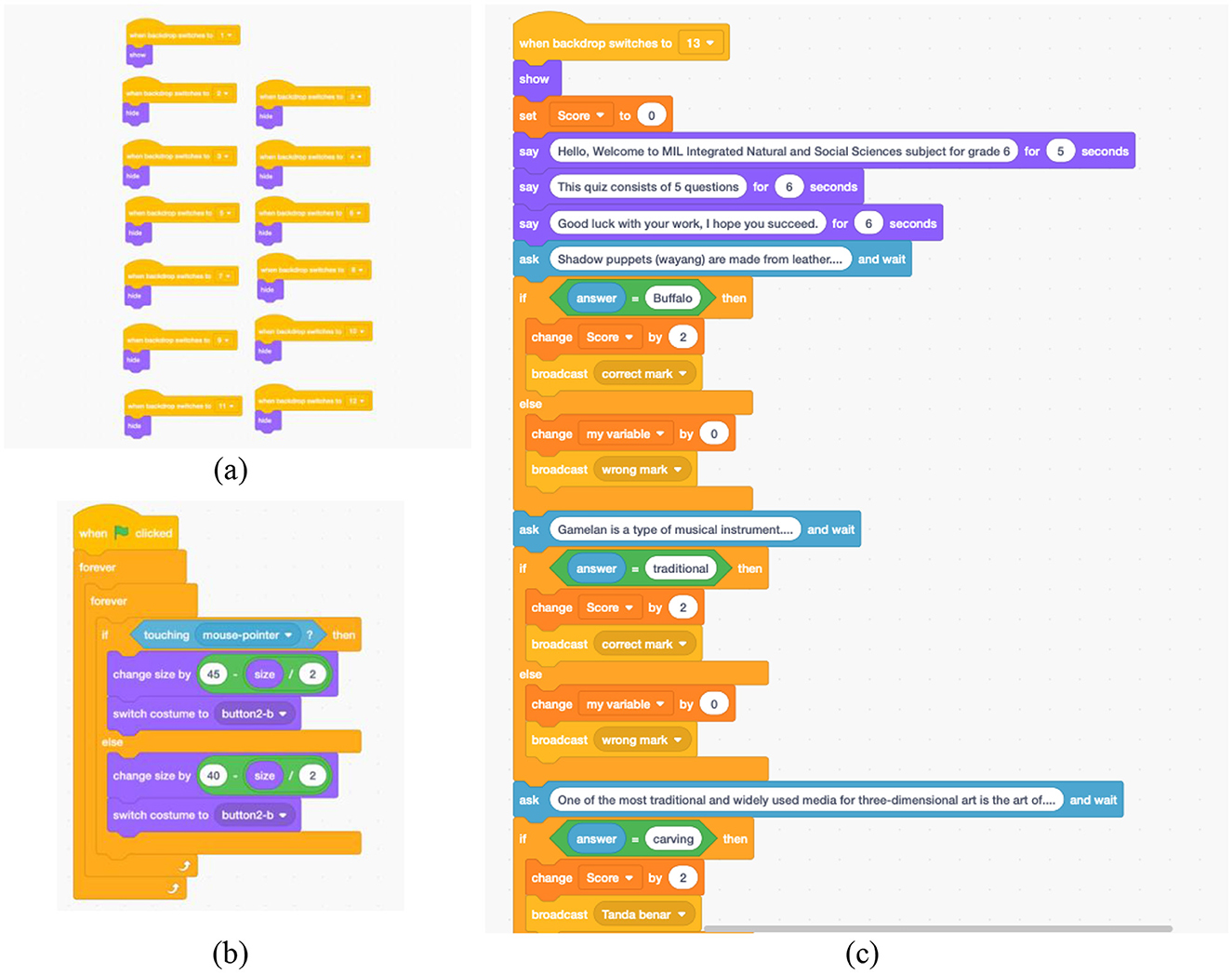
Figure 3. Sprite coding block. (a) Sprite coding blocks are shown or hidden. (b) Coding blocks of right or wrong answers and scoring on quizzes. (c) Coding blocks quiz clues and moving stage.
The steps taken in the design phase include project documentation, developing storyboards, designing interfaces, developing prototypes, and using visual design. Each stage involves different software, and the complete details of the software used are shown in Table 2. This application generally consists of two parts, namely materials and questions. Questions are tailored to the user's level; the higher the level, the more challenging the questions.
4.3 Development phase
In the product development phase, the prototype undergoes refinement to evolve into a fully developed product. These improvements are informed by interviews with three experienced professionals, each with over a decade of expertise in their respective fields. The specialists come from diverse backgrounds, including multimedia, teaching and learning, game development, and educational software design and evaluation. This interdisciplinary approach ensures a balanced perspective by integrating multiple areas of expertise.
The interviews were structured into three main sections. Each expert responded to five questions focusing on the role of digital games in evaluating mobile applications, particularly regarding their effectiveness in achieving developers' intended outcomes. In Part 1, we collected demographic information, details about pedagogical training, and prior experience with Scratch and game-based learning. Part 2 examined the experts' perspectives on instructional design, learner engagement, and the application's usability from a classroom standpoint. Part 3 documented their suggestions and evaluative feedback on the developed learning media. A summary of the experts' backgrounds is presented in Table 3.
Table 4 presents the outcomes related to the information presented in the digital games. This part includes five interrogatories that address student issues, such as misconceptions, underlying science concepts in Wabimendu material, and self-development strategies. The specifics of the questions for this section are given in Table 4.
Part C contains questions on color design alongside provided MIL enhancements and the use of Scratch vernacular in the Wabimendu MIL development. All questions and expert assessments from part C can be found in Table 5.
Based on the input obtained from experts, the MIL wabimedu prototype received significant improvements. In the material section, exploration of the material needs to be deeper. The addition of using more engaging visual and audio is also a valuable input received. Overall, the MIL wabimedu product has been successfully developed. The results of the development process are illustrated in Figure 4.
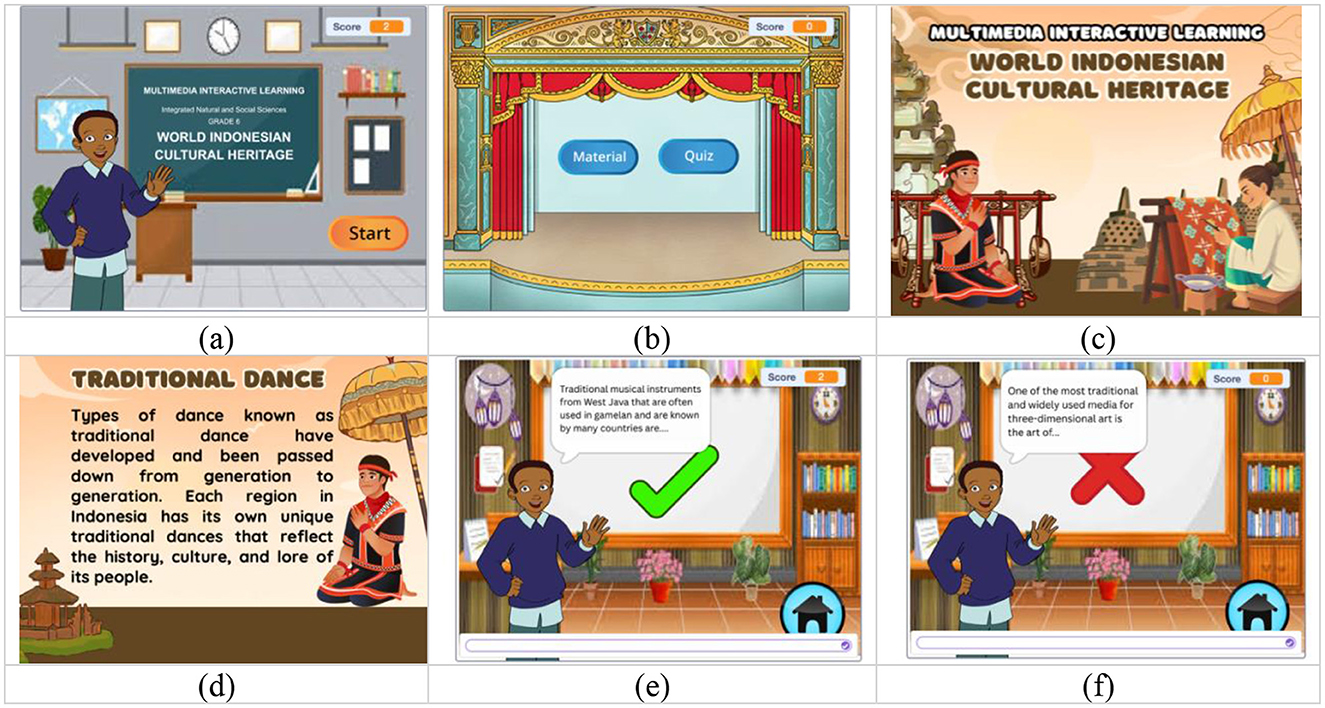
Figure 4. Wabimedu interface (a) welcoming screen; (b) menu stage containing learning materials and quizzes (c) material interface 1, (d) material interface 2, (e) quiz stage with correct answers, (f) quiz stage with wrong answers.
4.4 Implementation of multimedia interactive learning Scratch Wabimendu (World Indonesian Cultural Heritage)
The quantitative data presented in Table 6 and visualized in Figure 4 reveal significant improvements in student learning outcomes following the implementation of the Scratch Wabimendu multimedia interactive learning tool. The experimental group, which engaged with the Scratch Wabimendu platform, demonstrated a notable increase in mean scores from a pretest average of 50.66 to a posttest average of 75.00. This improvement corresponds to a normalized gain (N-Gain) of 0.493, indicating a moderate gain in learning. In contrast, the control group, which experienced conventional learning methods, showed a more minor increase in mean scores from 48.29 to 59.08, with an N-Gain of 0.209, classified as a low gain.
The distribution of scores depicted in Figure 5 further illustrates these patterns. Panel (a) shows the control group's score distribution with a modest upward shift post-intervention, while panel (b) highlights a more pronounced improvement in the experimental group, with a broader spread of higher posttest scores. This suggests that students using the Scratch Wabimendu tool not only improved on average but also achieved higher maximum scores, reflecting enhanced comprehension and mastery of the material.
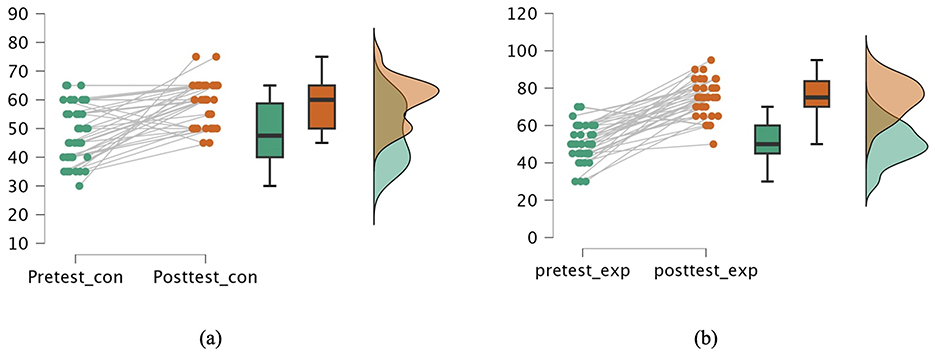
Figure 5. Visualization of normalized gain, data distribution, and improvement of (a) control class; (b) experiment class.
These results underscore the effectiveness of the Scratch Wabimendu multimedia interactive learning tool in fostering greater student engagement and understanding compared to traditional instructional approaches. The higher normalized gain in the experimental group indicates that the interactive, culturally rich, and gamified learning environment provided by Scratch Wabimendu significantly supports improved learning outcomes in the context of the Natural and Social Sciences (IPAS). This evidence aligns with the tool's design goals to increase motivation and active participation, ultimately leading to better academic performance.
These results underscore the effectiveness of the Scratch Wabimendu multimedia interactive learning tool in fostering greater student engagement and understanding compared to traditional instructional approaches. The higher normalized gain in the experimental group indicates that the interactive, culturally rich, and gamified learning environment provided by Scratch Wabimendu significantly supports improved learning outcomes in the context of the Natural and Social Sciences (IPAS). This evidence aligns with the tool's design goals to increase motivation and active participation, ultimately leading to better academic performance.
The t-test analysis results presented in Table 7 demonstrate statistically significant improvements in student learning outcomes for both the control and experimental groups. Specifically, the control group showed a significant increase in posttest scores compared to pretest scores (t = 5.651, df = 37, p < 0.001), indicating that conventional learning methods did yield measurable gains. However, the experimental group, which utilized the Scratch Wabimendu multimedia interactive learning tool, exhibited an even more pronounced improvement (t = 10.640, df = 37, p < 0.001), reflecting a more substantial effect of the intervention.
The Cohen's d value for the control group was significant (d = 0.917), indicating that the conventional instruction did produce a substantial and educationally meaningful improvement in student scores. However, the effect size for the experimental group was exceptionally large (d = 1.726). An effect size of this magnitude signifies a profoundly impactful intervention. In practical terms, it means that the average student in the experimental group scored approximately 1.73 standard deviations higher than they did before the intervention, a difference that is not only statistically significant but also observable in terms of student mastery and comprehension in a real-world classroom setting. The fact that the effect size for the “Wabimendu” group was nearly double that of the control group underscores the powerful and superior impact of the interactive learning tool. This suggests that the interactive, gamified, and culturally immersive features of the Scratch platform were highly effective at facilitating deeper understanding and retention of the cultural heritage content compared to traditional methods.
5 Discussion
The findings of this study reveal a significant enhancement in student learning outcomes through the use of the Scratch Wabimendu multimedia interactive learning (MIL) tool compared to conventional instructional methods. Quantitative data demonstrated that students exposed to the Scratch Wabimendu platform achieved a moderate normalized gain (N-Gain = 0.493), which is substantially higher than the low gain observed in the control group (N-Gain = 0.209). This improvement is further supported by the statistically significant increase in posttest scores for both groups; however, the experimental group exhibited a notably larger effect size (Cohen's d = 1.726) compared to the control group (d = 0.917), indicating a more profound impact of the interactive learning tool on student achievement. These results highlight the effectiveness of incorporating gamified, culturally rich multimedia content into the Natural and Social Sciences curriculum, promoting deeper comprehension and retention of material (Jivani et al., 2024; Parvathy and Mishra, 2023).
Expert evaluations corroborated these quantitative outcomes, highlighting the clarity, engagement, and alignment of the MIL content with the national curriculum. The experts praised the intuitive design and the culturally relevant visuals and narratives embedded within the Scratch Wabimendu tool, which collectively enhanced learner motivation and participation. They also recommended expanding the scope of materials, increasing the complexity of quiz questions, and incorporating additional multimedia elements such as audio and images to further enrich the learning experience. These suggestions point to the potential for continuous improvement and scalability of the platform, ensuring it remains responsive to diverse learner needs and evolving educational standards.
The profound impact of the “Wabimendu” tool can be attributed to the synergistic effect of its core design elements, which directly address the shortcomings of traditional pedagogy. Unlike passive, behaviorist-aligned methods, the MIL tool's success stems from its constructivist approach. The interactive quizzes and scoring mechanisms provided students with agency and immediate feedback, which are known to enhance engagement and motivation (Dicheva et al., 2019; Liu et al., 2024). This active participation contrasts sharply with the passive consumption of information typical in conventional classrooms. As stated by Taxipulati and Lu (2021), Immediate feedback provides timely guidance and helps correct errors promptly. As Lu et al. (2023) posited in their research, students who received immediate feedback outperformed those who received delayed feedback. Multimedia integration is also a significant factor that plays a role in this matter. The use of culturally relevant animations, graphics, and text aligns with Mayer's (2014) Cognitive Theory of Multimedia Learning. This dual-channel approach likely reduced cognitive load and made complex cultural concepts more accessible and memorable for young learners (Taxipulati and Lu, 2021). Furthermore, by embedding the curriculum within familiar and significant cultural contexts, such as batik and wayang kulit, the learning material became more relevant and meaningful to students (Anugrah, 2021; Kasinathan et al., 2024). This approach validates culturally based learning theories, which posit that connecting education to students' cultural backgrounds fosters a stronger sense of identity and interest in the subject matter.
The findings of this study align closely with prior research demonstrating the effectiveness of Scratch as a tool for enhancing student motivation and comprehension, particularly in science and mathematics education. Previous studies by Azman et al. (2025) and Kalemkuş and Kalemkuş (2025) have shown that Scratch's interactive and gamified environment fosters greater engagement and understanding, which is consistent with the moderate normalized gain and significant learning improvements observed in this study. This research extends those findings by applying Scratch-based gamified learning to the domain of cultural heritage education, an area less explored in existing literature, thereby addressing a notable gap in the integration of digital literacy and project-based learning within the national curriculum framework (Jun and Lucas, 2025; Rahmi et al., 2025). The results also strongly support constructivist learning theory, which posits that learners actively construct knowledge through interaction and experience rather than passively receiving information (Brau, 2020). The Scratch Wabimendu tool's design encourages students to engage creatively and analytically with cultural content, facilitating deeper cognitive processing and knowledge construction as described by Ansar et al. (2021) and Wallace (2014). This active learning approach contrasts with traditional behaviorist methods and aligns with the Zone of Proximal Development framework (Zhang et al., 2018), where scaffolded support enables learners to progressively master complex concepts.
Moreover, the study's findings reinforce Mayer (2024) Cognitive Theory of Multimedia Learning, which emphasizes the effectiveness of combining text, visuals, and interactivity to enhance understanding and retention. The multimedia elements of Scratch Wabimendu, such as animations, quizzes, and culturally relevant graphics can create a rich, dual-channel learning experience that supports cognitive processing and reduces extraneous load, as (Mayer, 2014, 2024) suggests. Culturally based learning approaches, as highlighted by Young (2014), are also supported by the study's outcomes. Integrating Indonesian cultural heritage into the learning process increased student interest and appreciation, fostering a stronger connection to national identity. This culturally responsive pedagogy not only enriches content relevance but also supports social and emotional learning by nurturing pride and awareness of cultural roots.
For educators, Scratch Wabimendu offers a user-friendly, curriculum-aligned resource that can be readily adapted and expanded. Expert feedback suggests that incorporating richer multimedia content such as audio, images, and more challenging quizzes would further deepen engagement and learning outcomes. This adaptability ensures that the tool can evolve with pedagogical needs and technological advancements, making it a sustainable asset in diverse classroom settings.
6 Conclusion
Game-based learning and gamification are widely recognized as among the most effective teaching strategies in modern education. Beyond fostering student engagement, these approaches improve educational outcomes by integrating gaming principles into learning systems. The Wabimendu (World Indonesian Cultural Heritage) game, for instance, demonstrates significant potential as a teaching tool for upper elementary school students. Developed using the ADDIE instructional design model, the game streamlines the creation process while ensuring alignment with learning objectives. The rigorous application of ADDIE guarantees that the MIL Wabimendu digital game is both educationally valuable and optimally designed. This assertion is supported by expert evaluations conducted at each development and review phase, which served as critical checkpoints for refining the game's effectiveness. In additions, the implementation stage shows that MIL Wabimendu based on N-Gain and T-Test analysis can improve learning outcomes. These evaluations confirm its suitability as an innovative educational resource, grounded in evidence-based principles of game-based learning and curriculum design.
7 Limitations
While this research provides solid implications for the usefulness of the “Wabimendu” learning media, there are some considerations that limit and inform the context of the findings, as well as offer implications for future research.
First, the sample was confined in its locality and specificity. Participants were from a single administrative area (Bae District in Kudus Regency, Indonesia), and the sample size included 76 students. This limited geographical area and sample size may limit the potential to generalize the current findings to student populations in other areas or different forms of education in this district. It would widen the understanding of the effectiveness of the tool if future studies replicate the study with larger and more distinctive samples across multiple districts.
Second, the study's design assessed learning outcomes from an immediate pretest and posttest. While the pre-post test was useful for determining the acquirement of knowledge at a short-term timeframe, the study cannot speak to long-term retention of the material presented in the course or the longitudinal engagement by students. The high engagement could potentially be influenced by the “novelty effect” of working with a new technology; therefore, it would be useful to assess the durability of learning outcomes with some type of follow-up measurement in future studies.
Data availability statement
The raw data supporting the conclusions of this article will be made available by the authors, without undue reservation.
Ethics statement
The studies involving humans were approved by Ethics Committee for Research Involving Human Subjects, Universitas Muria Kudus, Ref. 403/MPD.FKIP.UMK/B.15.56/XI/2024. The studies were conducted in accordance with the local legislation and institutional requirements. Written informed consent for participation in this study was provided by the participants' legal guardians/next of kin. Written informed consent was obtained from the individual(s) for the publication of any potentially identifiable images or data included in this article.
Author contributions
IP: Supervision, Conceptualization, Methodology, Data curation, Investigation, Writing – original draft, Formal analysis, Resources, Writing – review & editing. AR: Methodology, Conceptualization, Investigation, Project administration, Writing – review & editing, Formal analysis, Writing – original draft. MA: Data curation, Supervision, Methodology, Conceptualization, Writing – review & editing, Writing – original draft. NF: Supervision, Writing – review & editing, Formal analysis, Methodology, Writing – original draft, Conceptualization. HM: Writing – review & editing, Writing – original draft, Software, Formal analysis, Data curation.
Funding
The author(s) declare that no financial support was received for the research and/or publication of this article.
Acknowledgments
The authors wish to thank the Universitas Muria Kudus for supporting this research.
Conflict of interest
The authors declare that the research was conducted in the absence of any commercial or financial relationships that could be construed as a potential conflict of interest.
Generative AI statement
The author(s) declare that no Gen AI was used in the creation of this manuscript.
Any alternative text (alt text) provided alongside figures in this article has been generated by Frontiers with the support of artificial intelligence and reasonable efforts have been made to ensure accuracy, including review by the authors wherever possible. If you identify any issues, please contact us.
Publisher's note
All claims expressed in this article are solely those of the authors and do not necessarily represent those of their affiliated organizations, or those of the publisher, the editors and the reviewers. Any product that may be evaluated in this article, or claim that may be made by its manufacturer, is not guaranteed or endorsed by the publisher.
References
Agarkar, S. C. (2019). Influence of learning theories on science education. Resonance 24, 847–859. doi: 10.1007/s12045-019-0848-7
Anderson, L. W., Krathwohl, D. R., Airasian, P. W., Cruikshank, K. A., Mayer, R. E., Pintrich, P. R., et al. (2001). A Taxonomy for Learning, Teaching, and Assessing: A Revision of Bloom's Taxonomy of Educational Objectives. New York, NY: Longman.
Anish, P. R., Joshi, V., Sonar, P., and Ghaisas, S. (2021). “Writaupair: assistive platform for children with writing difficulties,” in Proceedings - 2021 IEEE 22nd International Conference on Information Reuse and Integration for Data Science, IRI 2021 (Piscataway, NJ: IEEE), 380–384.
Ansar, A., Rafi, A., and Rizvi, R. M. (2021). Is behaviourism really dead? A scoping review to document the presence of behaviourism in current medical education. J. Pak. Med. Assoc. 71, 1214–1220. doi: 10.47391/JPMA.830
Anugrah, I. R. (2021). Students' perspectives on Batik Cirebon for high school chemistry embedded STEM learning. J. Phys. Conf. Ser. 1957:012030. doi: 10.1088/1742-6596/1957/1/012030
Azman, M. N. A., Hussain, M. A. bin M., and Mustofa, H. A. (2025). The development of scratch based virtual lab game on electrical topics. Multidiscip. Sci. J. 7, 2025082. doi: 10.31893/MULTISCIENCE.2025082
Bada, J. K., Atcero, M., Dopia, B. A., Ayikoru, M., Asianzu, E., and Abima, B. (2024). Applying ADDIE model to develop multimedia lessons for adolescent reproductive health education in Uganda. Univ. Dar Es Salaam Libr. J. 18, 82–97. doi: 10.4314/udslj.v18i2.7
Batni, B., Junaini, S. N., Sidi, J., Mustafa, W. A., and Ismail, Z. I. A. (2025). Current research trends of scratch block based programming for K-12: a systematic review. J. Adv. Res. Appl. Sci. Eng. Technol. 51, 138–152. doi: 10.37934/araset.51.2.138152
Brau, B. (2020). “Constructivism,” in The Students' Guide to Learning Design and Research (Provo: EdTech Books). doi: 10.59668/10
Dawes Duraisingh, L., Blair, S., and Aguiar, A. (2021). Learning about culture(s) via intercultural digital exchange: opportunities, challenges, and grey areas. Intercult. Educ. 32, 259–279. doi: 10.1080/14675986.2021.1882759
Dicheva, D., Irwin, K., and Dichev, C. (2019). Exploring learners experience of gamified practicing: for learning or for fun? Int. J. Serious Games 6, 5–21. doi: 10.17083/ijsg.v6i3.299
Dúo-Terrón, P. (2023). Analysis of scratch software in scientific production for 20 years: programming in education to develop computational thinking and STEAM disciplines. Educ. Sci. 13:404. doi: 10.3390/educsci13040404
Fatimah, H., Fitriani, S., and Priyono, D. (2024). Sekolah penggerak program: a comparative case study in Indonesia's elementary school context. J. Educ. Learn. 18, 950–959. doi: 10.11591/edulearn.v18i3.21206
Hadjeris, F. (2025). “Embracing the “pluriversal” through linguistic citizenship Algerian EFL teachers' didactic engagement with the instructional materials and its implications for teaching for global citizenship,” in Teaching and Researching Interculturality in the Middle East and North Africa (London: Routledge), 11–32.
Hasse, C. (2015). An Anthropology of Learning: On Nested Frictions in Cultural Ecologies. Dordrecht: Springer.
Jivani, S. R., Chetehouna, M., Hafeez, S., and Adjali, M. H. (2024). Effects of game-based learning on engagement and academic performance for undergraduate science and engineering students. Int. J. Eng. Educ. 40, 16–22. Available online at: https://qmro.qmul.ac.uk/xmlui/handle/123456789/94414
Jun, M., and Lucas, T. (2025). Gamification elements and their impacts on education: a review. Multidiscip. Rev. 8:2025155. doi: 10.31893/multirev.2025155
Kalemkuş, J., and Kalemkuş, F. (2025). The effects of designing scientific experiments with visual programming language on learning outcomes. Sci. Educ. 34, 2409–2430. doi: 10.1007/s11191-024-00546-8
Kasinathan, V., Rubasundram, G. A., and Fuu, W. C. (2024). Revitalizing ancestral values through technology: using Wayang Kulit to engage Gen Z in cultural and educational innovation. J. Ecohumanism 3, 2940–2952. doi: 10.62754/joe.v3i7.4429
Krejcie, R. V., and Morgan, D. W. (1970). Determining sample size for research activities. Educ. Psychol. Meas. 30, 607–610.
Liu, R., Zhang, L., Cao, Z., and Mi, J. (2024). Influence of gamification affordance on young citizens' motivation and learning performance toward digital civic education. J. Chin. Gov. 9, 244–278. doi: 10.1080/23812346.2024.2327735
Lu, K., Pang, F., and Shadiev, R. (2021). Understanding the mediating effect of learning approach between learning factors and higher order thinking skills in collaborative inquiry-based learning. Educ. Technol. Res. Dev. 69, 2475–2492. doi: 10.1007/s11423-021-10025-4
Lu, X., Wang, W., Motz, B. A., Ye, W., and Heffernan, N. T. (2023). Immediate text-based feedback timing on foreign language online assignments: how immediate should immediate feedback be? Comput. Educ. Open 5:100148. doi: 10.1016/j.caeo.2023.100148
Lynn, L. J. (2020). “Effective integration of technology in inquiry learning: themes and examples,” in Handbook of Research on Modern Educational Technologies, Applications, and Management Vol. 2 (Hershey, PA: IGI Global), 664–676. doi: 10.4018/978-1-7998-3476-2.ch041
Ma, X., Lin, S. E., Gu, M., Sun, J., and Ma, J. (2024). The meaning, value, and realisation of internet-based culturally responsive teaching. Appl. Math. Nonlinear Sci. 9, 1–15. doi: 10.2478/amns.2023.2.00167
Machumu, H., and Zhu, C. (2017). The relationship between student conceptions of constructivist learning and their engagement in constructivist based blended learning environments. Int. J. Learn. Technol. 12, 253–272. doi: 10.1504/IJLT.2017.088408
Malliga, P., Dinesh Kumar, K. S. A., Gangathulasi, J., Velu, S., and Arivalagan, S. (2024). “Comparative analysis of traditional instruction and POGIL: a student-centered learning approach in civil engineering,” in ASEE Annual Conference and Exposition, Conference Proceedings. Available online at: https://www.scopus.com/inward/record.uri?eid=2-s2.0-85202050598&partnerID=40&md5=28151c96aee51208e989b008a28a9969 (Accessed April 14, 2025).
Maloney, J., Resnick, M., Rusk, N., Silverman, B., and Eastmond, E. (2010). The scratch programming language and environment. ACM Trans. Comput. Educ. 10:4. doi: 10.1145/1868358.1868363
Mayer, R. E. (2014). “Cognitive theory of multimedia learning,” in The Cambridge Handbook of Multimedia Learning, 2nd ed. 43–71.
Mayer, R. E. (2024). The past, present, and future of the cognitive theory of multimedia learning. Educ. Psychol. Rev. 36:23. doi: 10.1007/s10648-023-09842-1
Mengesha, A. K., Ayele, H. S., Misker, M. F., and Beyna, A. T. (2024). Assessing the effectiveness of flipped classroom teaching–learning method among undergraduate medical students at gondar university, college of medicine and health sciences: an interventional study. BMC Med. Educ. 24:1. doi: 10.1186/s12909-024-06105-7
Miguel-Revilla, D., Calle-Carracedo, M., and Sánchez-Agustí, M. (2020). Fostering engagement and historical understanding with a digital learning environment in secondary education. E-Learn. Digit. Media 18, 344–360. doi: 10.1177/2042753020957452
Miura, K. (2022). A dilemma of World Heritage ideals and challenges in Southeast Asia. Int. J. Cult. Prop. 29, 433–457. doi: 10.1017/S094073912200025X
Mo, W., Zhang, Y., Fu, Y., Lin, J., Gao, H., and Lin, Y. (2021). “Effects of a scratch-based experiential learning approach on students' math learning achievements and interest,” in Proceedings - 2021 International Symposium on Educational Technology, ISET 2021 (Piscataway, NJ: IEEE), 261–265.
Mohd Asri, A. S., and Jamaludin, K. A. (2022). Potential scratch games in developing students' thinking skills. Malays. J. Soc. Sci. Humanit. 7:e002004. doi: 10.47405/MJSSH.V7I12.2004
Mokhsin, M., Zainol, A. S., Som, M. H. M., Kamarulzaman, U., and Foad, N. A. A. (2019). Barriers for digital game-based learning teaching method: a performance on primary school Malay historical subject. Int. J. Eng. Adv. Technol. 9, 1703–1707. doi: 10.35940/ijeat.A2641.109119
Mustofa, H. A., Gunawan, G., and Kosim, K. (2021). Validity of documentary video learning media based on local content traditional musical instruments on sound waves. J. Pijar Mipa 16, 576–582. doi: 10.29303/jpm.v16i5.1189
Mustofa, H. A., Sandanadas, E., Mohtar, L. E., and Faresta, R. A. (2024). Identifying student prior-knowledge and conceptual changes profile on Newton law using by using POE (predict, observe, and explain) as probing understanding strategy. J. Sci. Math. Lett. 12, 80–91. doi: 10.37134/JSML.VOL12.1.10.2024
Nyathi, V. S., and Sisimayi, T. P. (2024). “Adaptive learning technologies for higher education: exploring the use of interactive online learning platforms for higher education,” in Adaptive Learning Technologies for Higher Education (Hershey, PA: IGI Global), 91–124.
Parmin, P., Rahayu, E. F., Ifriza, Y. N., El Islami, A. Z., Saminto, S., and Mustofa, H. A. (2024). Ethnicity on the teaching skills of culturally literate prospective science teachers. Philipp. J. Sci. 153, 1051–1059. doi: 10.56899/153.03.25
Parvathy, V., and Mishra, D. (2023). “Challenges of multimedia education in the lives of human beings,” in Lecture Notes in Networks and Systems, Vol. 782 (Singapore: Springer), 149–159.
Poehner, M. E., and Lantolf, J. P. (2021). The ZPD, second language learning, and the mansposition ~ transformation dialectic. Cult. Hist. Psychol. 17, 31–41. doi: 10.17759/CHP.2021170306
Purbasari, I., Yusuf, M., Subagya Marmoah, S., Fajrie, N., and Mustofa, H. A. (2023). Bamboo woven websites for elementary school students through social collaborative learning approach. J. Adv. Res. Appl. Sci. Eng. Technol. 31, 315–325. doi: 10.37934/araset.31.1.315325
Rahmi, I., Rimenda, T., and Ariyanti, T. D. (2025). Gamification as an alternative to increase students' motivation: a scoping review. J. Educ. Learn. 19, 1125–1133. doi: 10.11591/edulearn.v19i2.21771
Ratri, D. P., Rachmajanti, S., Anugerahwati, M., Laksmi, E. D., and Gozali, A. (2025). Fostering cultural competence: developing an English syllabus for young learners in the Indonesian EFL context with emphasis on local culture to maintain students' identity. Cogent Educ. 12:2440177. doi: 10.1080/2331186X.2024.2440177
Sáez-López, J. M., Del Olmo-Muñoz, J., González-Calero, J. A., and Cózar-Gutiérrez, R. (2020). Exploring the effect of training in visual block programming for preservice teachers. Multimodal Technol. Interact. 4, 1–11. doi: 10.3390/mti4030065
Stylianou, V., and Savva, A. (2022). “Learn-by-doing virtually; a gamified and metaverse design for group projects aiming at enhancing constructivist and collaborative learning,” in AIS SIGED International Conference on Information Systems Education and Research 2022 (Copenhagen), 129–141.
Sutini, C., and Rasyid, Y. (2021). The relevance of reading teaching material using new technology. J. Phys. Conf. Ser. 1764:012145. doi: 10.1088/1742-6596/1764/1/012145
Taxipulati, S., and Lu, H. D. (2021). The influence of feedback content and feedback time on multimedia learning achievement of college students and its mechanism. Front. Psychol. 12:706821. doi: 10.3389/fpsyg.2021.706821
Trinh, A. H., and Dinh, H. (2024). Language and home-culture integrated online learning curriculum for developing intercultural communicative competence. J. Multicult. Educ. 18, 38–52. doi: 10.1108/JME-09-2023-0097
Wallace, C. S. (2014). “Overview of the role of teacher beliefs in science education,” in The Role of Science Teachers' Beliefs in International Classrooms: From Teacher Actions to Student Learning (Dordrecht: Springer), 17–31.
Xu, Y., and Zhao, Y. (2024). “Interactive design method of multi person VR distance education for new media art teaching,” in e-Learning, e-Education, and Online Training. eLEOT 2023. Lecture Notes of the Institute for Computer Sciences, Social Informatics and Telecommunications Engineering (Cham: Springer Nature Switzerland).
Young, P. A. (2014). “The presence of culture in learning,” in Handbook of Research on Educational Communications and Technology, 4th ed. 349–361.
Zhang, A., Gong, Y., Chen, Q., Jin, X., Mu, Y., and Lu, Y. (2025). Driving innovation and sustainable development in cultural heritage education through digital transformation: the role of interactive technologies. Sustainability 17:314. doi: 10.3390/su17010314
Zhang, S., Lai, W., Song, J., Yu, X., Liao, X., and Hao, J. (2018). “Scaffolding instruction design research based on zone of proximal development of learning community,” in Proceedings - 2018 7th International Conference of Educational Innovation through Technology, EITT 2018 (Auckland, New Zealand), 258–262.
Keywords: multimedia interactive learning, Scratch, Wabimedu, integrated science-social learning, learning activities
Citation: Pratiwi IA, Rahmawati A, Azman MNA, Fajrie N and Mustofa HA (2025) Development and effectiveness of multimedia interactive learning Scratch Wabimendu (World Indonesian Cultural Heritage). Front. Educ. 10:1628412. doi: 10.3389/feduc.2025.1628412
Received: 14 May 2025; Accepted: 15 September 2025;
Published: 08 October 2025.
Edited by:
Yudhi Arifani, Universitas Muhammadiyah Gresik, IndonesiaReviewed by:
Jesi Alexander Alim, Riau University, IndonesiaAndi Ichsan Mahardika, Lambung Mangkurat University, Indonesia
Copyright © 2025 Pratiwi, Rahmawati, Azman, Fajrie and Mustofa. This is an open-access article distributed under the terms of the Creative Commons Attribution License (CC BY). The use, distribution or reproduction in other forums is permitted, provided the original author(s) and the copyright owner(s) are credited and that the original publication in this journal is cited, in accordance with accepted academic practice. No use, distribution or reproduction is permitted which does not comply with these terms.
*Correspondence: Ika Ari Pratiwi, aWthLmFyaUB1bWsuYWMuaWQ=
 Ika Ari Pratiwi
Ika Ari Pratiwi Anita Rahmawati2
Anita Rahmawati2 Mohamed Nor Azhari Azman
Mohamed Nor Azhari Azman Hisbulloh Als Mustofa
Hisbulloh Als Mustofa